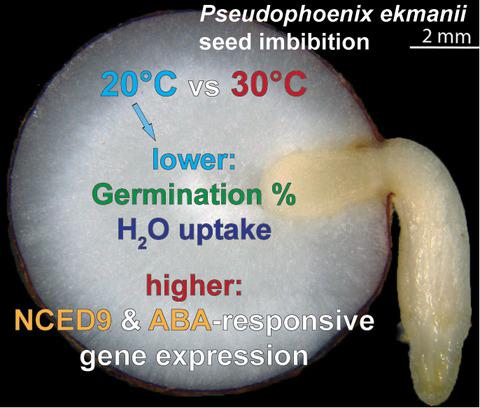当前位置:
X-MOL 学术
›
Plant Biol.
›
论文详情
Our official English website, www.x-mol.net, welcomes your feedback! (Note: you will need to create a separate account there.)
Pseudophoenix ekmanii (Arecaceae) seeds at suboptimal temperature show reduced imbibition rates and enhanced expression of genes related to germination inhibition.
Plant Biology ( IF 3.9 ) Pub Date : 2020-07-01 , DOI: 10.1111/plb.13156 A M Visscher 1 , E Castillo-Lorenzo 1, 2 , P E Toorop 1 , L Junio da Silva 1 , M Yeo 1 , H W Pritchard 1
中文翻译:

次优温度下的拟南芥(Pseudophoenix ekmanii)(种子)显示出吸收速率降低和与发芽抑制相关的基因表达增强。
更新日期:2020-07-01
Plant Biology ( IF 3.9 ) Pub Date : 2020-07-01 , DOI: 10.1111/plb.13156 A M Visscher 1 , E Castillo-Lorenzo 1, 2 , P E Toorop 1 , L Junio da Silva 1 , M Yeo 1 , H W Pritchard 1
Affiliation

|
- Pseudophoenix ekmanii is a critically endangered palm species that can be found in the southeast of the Dominican Republic. The temperatures to which P. ekmanii seeds are exposed upon dispersal range from 32 to 23 °C (max and min) and can reach a low of approximately 20 °C in January. Our aim was to analyse the effect of suboptimal (20 °C) and optimal (30 °C) germination temperature on seed imbibition, moisture content, embryo growth and gene expression patterns in this tropical palm species.
- Seed imbibition was tracked using whole seeds, while moisture content was assessed for individual seed sections. Embryo and whole seed size were measured before and after full imbibition. For transcriptome sequencing, mRNA was extracted from embryo tissues only and the resulting reads were mapped against the Elaeis guineensis reference genome. Differentially expressed genes were identified after statistical analysis and subsequently probed for enrichment of Gene Ontology categories ‘Biological process’ and ‘Cellular component’.
- Our results show that prolonged exposure to 20 °C slows whole seed and embryo imbibition and causes germination to be both delayed and inhibited. Embryonic transcriptome patterns associated with the negative regulation of germination by suboptimal temperature include up‐regulation of ABA biosynthesis genes, ABA‐responsive genes, as well as other genes previously related to physiological dormancy and inhibition of germination.
- Thus, our manuscript provides the first insights into the gene expression patterns involved in the response to suboptimal temperature during seed imbibition in a tropical palm species.
中文翻译:

次优温度下的拟南芥(Pseudophoenix ekmanii)(种子)显示出吸收速率降低和与发芽抑制相关的基因表达增强。
- Pseudophoenix ekmanii是一种极度濒危的棕榈树种,可以在多米尼加共和国的东南部找到。散布的P. ekmanii种子暴露于的温度为32至23°C(最高和最低),一月份可能降至约20°C。我们的目的是分析次优(20°C)和最佳(30°C)发芽温度对这种热带棕榈树种种子吸收,水分含量,胚胎生长和基因表达模式的影响。
- 使用整粒种子来跟踪种子的吸收,同时评估单个种子切片的水分含量。在完全吸收之前和之后测量胚胎和整个种子的大小。对于转录组测序,仅从胚胎组织中提取mRNA,然后将所得的读图与Elaeis guineensis参考基因组作图。经过统计分析后,鉴定出差异表达的基因,随后探查其丰富的基因本体论类别“生物过程”和“细胞成分”。
- 我们的结果表明,长时间暴露于20°C会减慢整个种子和胚胎的吸收,并导致发芽被延迟和抑制。与次优温度对发芽的负调控相关的胚胎转录组模式包括上调ABA生物合成基因,ABA反应基因以及以前与生理休眠和抑制发芽有关的其他基因。
- 因此,我们的手稿提供了对热带棕榈树种种子吸收过程中对次优温度的响应所涉及的基因表达模式的初步见解。

























 京公网安备 11010802027423号
京公网安备 11010802027423号